The NVIDIA GeForce GTX Titan X Review
by Ryan Smith on March 17, 2015 3:00 PM ESTCompute
Shifting gears, we have our look at compute performance.
As we outlined earlier, GTX Titan X is not the same kind of compute powerhouse that the original GTX Titan was. Make no mistake, at single precision (FP32) compute tasks it is still a very potent card, which for consumer level workloads is generally all that will matter. But for pro-level double precision (FP64) workloads the new Titan lacks the high FP64 performance of the old one.
Starting us off for our look at compute is LuxMark3.0, the latest version of the official benchmark of LuxRender 2.0. LuxRender’s GPU-accelerated rendering mode is an OpenCL based ray tracer that forms a part of the larger LuxRender suite. Ray tracing has become a stronghold for GPUs in recent years as ray tracing maps well to GPU pipelines, allowing artists to render scenes much more quickly than with CPUs alone.
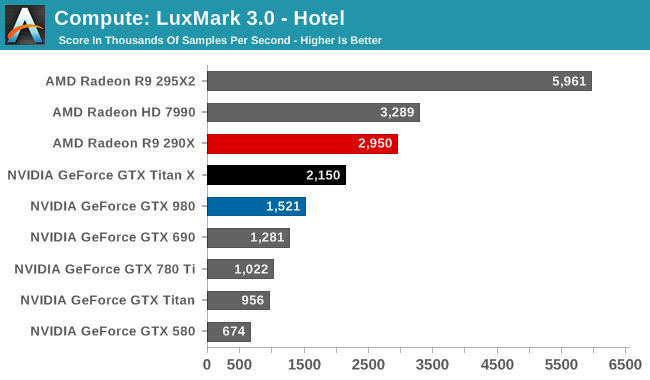
While in LuxMark 2.0 AMD and NVIDIA were fairly close post-Maxwell, the recently released LuxMark 3.0 finds NVIDIA trailing AMD once more. While GTX Titan X sees a better than average 41% performance increase over the GTX 980 (owing to its ability to stay at its max boost clock on this benchmark) it’s not enough to dethrone the Radeon R9 290X. Even though GTX Titan X packs a lot of performance on paper, and can more than deliver it in graphics workloads, as we can see compute workloads are still highly variable.
For our second set of compute benchmarks we have CompuBench 1.5, the successor to CLBenchmark. CompuBench offers a wide array of different practical compute workloads, and we’ve decided to focus on face detection, optical flow modeling, and particle simulations.
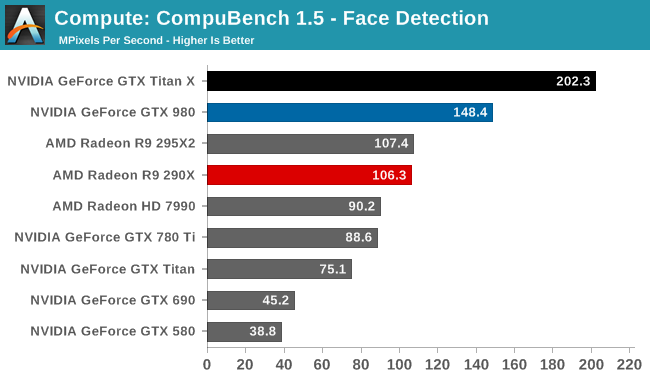
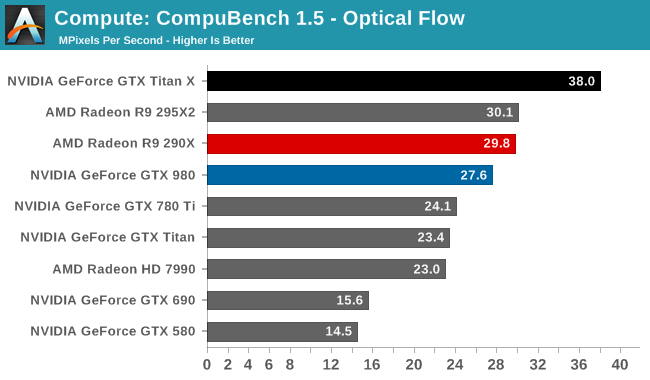
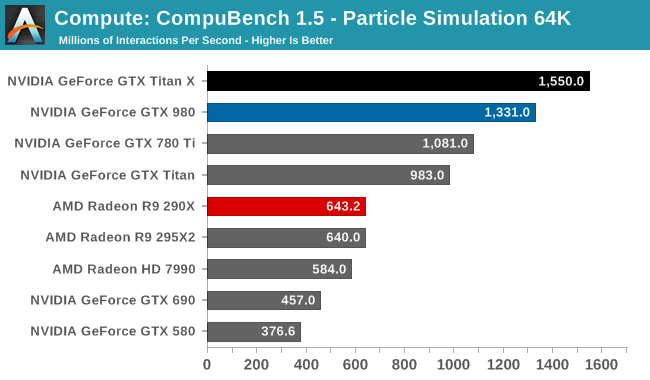
Although GTX Titan X struggled at LuxMark, the same cannot be said for CompuBench. Though the lead varies with the specific sub-benchmark, in every case the latest Titan comes out on top. Face detection in particular shows some massive gains, with GTX Titan X more than doubling the GK110 based GTX 780 Ti's performance.
Our 3rd compute benchmark is Sony Vegas Pro 13, an OpenGL and OpenCL video editing and authoring package. Vegas can use GPUs in a few different ways, the primary uses being to accelerate the video effects and compositing process itself, and in the video encoding step. With video encoding being increasingly offloaded to dedicated DSPs these days we’re focusing on the editing and compositing process, rendering to a low CPU overhead format (XDCAM EX). This specific test comes from Sony, and measures how long it takes to render a video.

Traditionally a benchmark that favors AMD, GTX Titan X closes the gap some. But it's still not enough to surpass the R9 290X.
Moving on, our 4th compute benchmark is FAHBench, the official Folding @ Home benchmark. Folding @ Home is the popular Stanford-backed research and distributed computing initiative that has work distributed to millions of volunteer computers over the internet, each of which is responsible for a tiny slice of a protein folding simulation. FAHBench can test both single precision and double precision floating point performance, with single precision being the most useful metric for most consumer cards due to their low double precision performance. Each precision has two modes, explicit and implicit, the difference being whether water atoms are included in the simulation, which adds quite a bit of work and overhead. This is another OpenCL test, utilizing the OpenCL path for FAHCore 17.
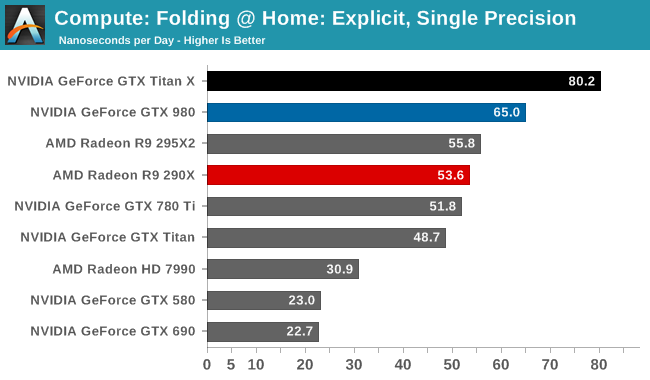
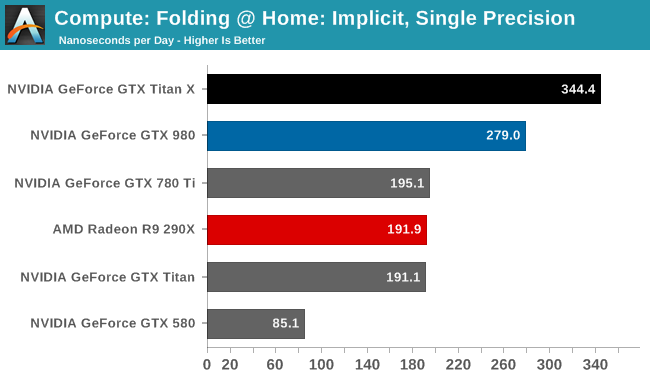
Folding @ Home’s single precision tests reiterate just how powerful GTX Titan X can be at FP32 workloads, even if it’s ostensibly a graphics GPU. With a 50-75% lead over the GTX 780 Ti, the GTX Titan X showcases some of the remarkable efficiency improvements that the Maxwell GPU architecture can offer in compute scenarios, and in the process shoots well past the AMD Radeon cards.
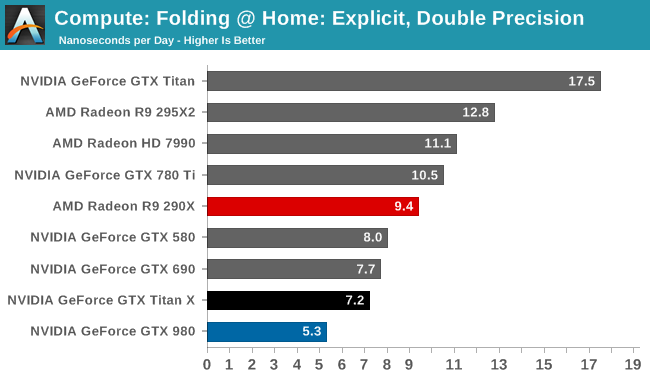
On the other hand with a native FP64 rate of 1/32, the GTX Titan X flounders at double precision. There is no better example of just how much the GTX Titan X and the original GTX Titan differ in their FP64 capabilities than this graph; the GTX Titan X can’t beat the GTX 580, never mind the chart-topping original GTX Titan. FP64 users looking for an entry level FP64 card would be well advised to stick with the GTX Titan Black for now. The new Titan is not the prosumer compute card that was the old Titan.
Wrapping things up, our final compute benchmark is an in-house project developed by our very own Dr. Ian Cutress. SystemCompute is our first C++ AMP benchmark, utilizing Microsoft’s simple C++ extensions to allow the easy use of GPU computing in C++ programs. SystemCompute in turn is a collection of benchmarks for several different fundamental compute algorithms, with the final score represented in points. DirectCompute is the compute backend for C++ AMP on Windows, so this forms our other DirectCompute test.
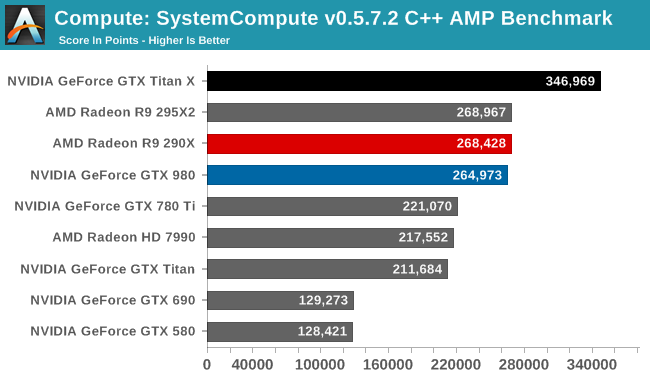
With the GTX 980 already performing well here, the GTX Titan X takes it home, improving on the GTX 980 by 31%. Whereas GTX 980 could only hold even with the Radeon R9 290X, the GTX Titan X takes a clear lead.
Overall then the new GTX Titan X can still be a force to be reckoned with in compute scenarios, but only when the workloads are FP32. Users accustomed to the original GTX Titan’s FP64 performance on the other hand will find that this is a very different card, one that doesn’t live up to the same standards.










276 Comments
View All Comments
nos024 - Wednesday, March 18, 2015 - link
Well lets see. Even when it launches, will it be readily available and not highly priced like the 290X. If the 290x was readily available when it was launched, I would've bought one.eanazag - Wednesday, March 18, 2015 - link
Based on leaked slides referencing Battlefield 4 at 4K resolution the 390X is 1.6x the 290X. In the context of this review results we could guess it comes up slightly short at 4K ultra and 10 fps faster than the Titan X at 4K medium. Far Cry 4 came in at 1.55 x the 290X.290X non-uber 4K ultra - BF4 - 35.5 fps x 1.6 = 56.8. >> Titan 58.3
290X non-uber 4K medium - BF4 - 65.9 fps x 1.6 = 105.44 >> Titan 94.8
290X non-uber 4K ultra - FC4 - 31.2 fps x 1.55 = 48.36 >> Titan 42.1
290X non-uber 4K medium - FC4 - 40.9 fps x 1.55 = 63.395 >> Titan 60.5
These numbers don't tell the whole story on how AMD arrived with the figures, but it paints the picture of a GPU that goes toe-to-toe with the Titan X. The slides also talk about a water cooler edition. I'm suspecting the wattage will be in the same ball park as the 290X and likely higher.
With the Titan X full breadth compute muscle, I am not sure what the 980 Ti will look like. I suspect Nvidia is holding that back based on whatever AMD releases, so they can unload a smack down trump card. Rumored $700 for the 390X WCE with 8GB HBM (high bandwidth memory - 4096 bit width) and in Q2 (April-June). Titan X and 390X at the same price given what I know at the moment I would go with the Titan X.
Stack your GPU $'s for July.
FlushedBubblyJock - Thursday, April 2, 2015 - link
If the R9 390X doesn't come out at $499 months and months from now, it won't be worth it.shing3232 - Tuesday, March 17, 2015 - link
1/32 FP32? so, this is a big gaming core.Railgun - Tuesday, March 17, 2015 - link
Exactly why it's not a $999 card.shing3232 - Tuesday, March 17, 2015 - link
but, it was priced at 999.Railgun - Tuesday, March 17, 2015 - link
What I mean is that it's not worth being a 999 card. Yes, it's priced at that, but it's value doesn't support it.Flunk - Tuesday, March 17, 2015 - link
Plenty of dolts bought the first Titan as a gaming card so I'm sure someone will buy this. At least there's a bigger performance difference between the Titan X and GTX 980 than there was between the Titan and GTX 780.Kevin G - Tuesday, March 17, 2015 - link
Except the GTX 780 came after the Titan launched. Rather it was the original Titan compared to the GTX 680 and here we see a similar gap between the Titan X and the GTX 980. It is also widely speculated that we'll see a cut down GM200 to fit between the GTX 980 and the Titan X so history looks like it will repeat itself.chizow - Tuesday, March 17, 2015 - link
@Railgun, I'd disagree and I was very vocal against the original Titan for a number of reasons. Mainly because Nvidia used the 7970 launch as an opportunity to jump their 2nd fastest chip as mainstream. 2ndly, because they held back their flagship chip nearly a full year (GTX 680 launched Mar 2012, Titan Feb 2013) while claiming the whole time there was no bigger chip, they tried to justify the higher price point because it was a "compute" card and lastly because it was a cut down chip and we knew it.Titan X isn't being sold with any of those pretenses and now that the new pricing/SKU structure has settled in (2nd fastest chip = new $500 flagship), there isn't any of that sticker shock anymore. Its the full chip, there's no complaints about them holding anything back, and 12GB of VRAM is a ridiculous amount of VRAM to stick on a card, and that costs money. If EVGA wants to release an $800 Classified 980 and people see value in it, then certainly this Titan X does as well.
At least for me, it is the more appealing option for me now than getting a 2nd 980 for SLI. Slightly lower performance, lower heat, no SLI/scaling issues, and no framebuffer VRAM concerns for the foreseeable future. I game at 2560x1440p on an ROG Swift btw, so that is right in this card's wheelhouse.